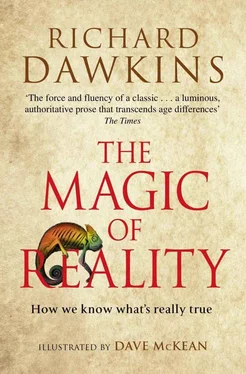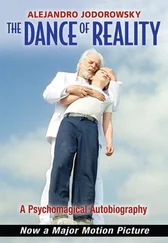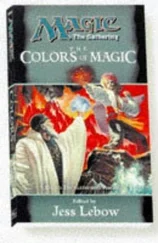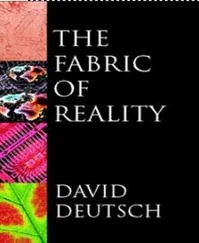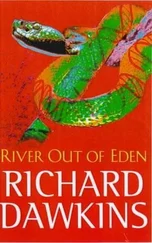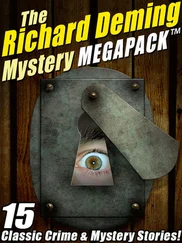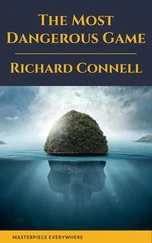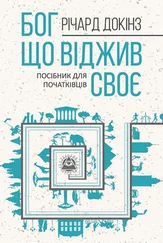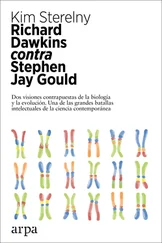Each genus belongs to a family , usually printed in ordinary ‘roman’ type with a capital initial. Cats (including lions, leopards, cheetahs, lynxes and lots of smaller cats) make up the family Felidae. Every family belongs to an order . Cats, dogs, bears, weasels and hyenas belong to different families within the order Carnivora. Monkeys, apes (including us) and lemurs all belong to different families within the order Primates. And every order belongs to a class. All mammals are in the class Mammalia.
Can you see the shape of a tree developing in your mind as you read this description of the sequence of groupings? It is a family tree: a tree with many branches, each branch having sub-branches, and each sub-branch having sub-sub-branches. The tips of the twigs are species. The other groupings – class, order, family, genus – are the branches and sub-branches. The whole tree is all of life on Earth.
Think about why trees have so many twigs. Branches branch. When we have enough branches of branches of branches, the total number of twigs can be very large. That’s what happens in evolution. Charles Darwin himself drew a branching tree as the only picture in his most famous book, On the Origin of Species . He sketched an early version in one of his notebooks some years earlier. At the top of the page he wrote a mysterious little message to himself: ‘I think’. What do you think he meant? Maybe he started to write a sentence and one of his children interrupted him so he never finished it. Maybe he found it easier to represent quickly what he was thinking in this diagram than in words. Perhaps we shall never know. There is other handwriting on the page, but it is hard to decipher. It is tantalizing to read the actual notes of a great scientist, written on a particular day and never meant for publication.
The following isn’t exactly how the tree of animals branched, but it gives you an idea of the principle. Imagine an ancestral species splitting into two species. If each of those then splits into two, that makes four. If each of them splits into two, that makes eight, and so on through 16, 32, 64, 128, 256, 512… You can see that, if you carry on doubling up, it doesn’t take long to get up into the millions of species. That probably makes sense to you, but you may be wondering why a species should split. Well, it’s for pretty much the same reason as human languages split, so let’s pause to think about that for a moment.
Pulling apart: how languages, and species, divide
Although the legend of the Tower of Babel is, of course, not really true, it does raise the interesting question of why there are so many different languages.
Just as some species are more similar than others and are placed in the same family, so there are also families of languages. Spanish, Italian, Portuguese, French and many European languages and dialects such as Romansch, Galician, Occitan and Catalan are all pretty similar to each other; together they’re called ‘Romance’ languages. The name actually comes from their common origin in Latin, the language of Rome, not from any association with romance, but let’s use an expression of love as our example. Depending on which country you are in, you might declare your feelings in one of the following ways: ‘Ti amo’, ‘Amote’, ‘T’aimi’ or ‘Je t’aime’. In Latin it would be ‘Te amo’ – exactly like modern Spanish.
To swear your love to someone in Kenya, Tanzania or Uganda you could say, in Swahili, ‘Nakupenda’. A bit further south, in Mozambique, Zambia, or Malawi where I was brought up, you might say, in the Chinyanja language, ‘Ndimakukonda’. In other so-called Bantu languages in southern Africa you might say ‘Ndinokuda’, ‘Ndiyakuthanda’ or, to a Zulu, ‘Ngiyakuthanda’. This Bantu family of languages is quite distinct from the Romance family of languages, and both are distinct from the Germanic family which includes Dutch, German and the Scandinavian languages. See how we use the word ‘family’ for languages, just as we do for species (the cat family, the dog family) and also, of course, for our own families (the Jones family, the Robinson family, the Dawkins family).
It isn’t hard to work out how families of related languages arise over the centuries. Listen to the way you and your friends speak to each other, and compare it to the way your grandparents speak. Their speech is only slightly different and you can easily understand them, but they are only two generations away. Now imagine talking, not to your grandparents but to your 25-greats-grandparents. If you happen to be English, that might take you back to the late fourteenth century – the lifetime of the poet Geoffrey Chaucer, who wrote descriptions like this:
He was a lord ful fat and in good poynt;
His eyen stepe, and rollynge in his heed,
That stemed as a forneys of a leed;
His bootes souple, his hors in greet estaat.
Now certeinly he was a fair prelaat;
He was nat pale as a forpyned goost.
A fat swan loved he best of any roost.
His palfrey was as broun as is a berye.
Well, it is recognizably English, isn’t it? But I bet you’d have a hard time understanding it if you heard it spoken. And if it was any more different you’d probably consider it a separate language, as different as Spanish is from Italian.
So, the language in any one place changes century by century. We could say it ‘drifts’ into something different. Now add the fact that people speaking the same language in different places don’t often have the opportunity to hear each other (or at least they didn’t before telephones and radios were invented); and the fact that language drifts in different directions in different places. This applies to the way it is spoken as well as to the words themselves: think how different English sounds in a Scottish, Welsh, Geordie, Cornish, Australian or American accent. And Scottish people can easily distinguish an Edinburgh accent from a Glasgow accent or a Hebridean accent. Over time, both the way the language is spoken and the words used become characteristic of a region; when two ways of speaking a language have drifted sufficiently far apart, we call them different ‘dialects’.
After enough centuries of drift, different regional dialects eventually become so different that people in one region can no longer understand people in another. At this point we call them separate languages. That is what happened when German and Dutch drifted, in separate directions, from a now extinct ancestral language. It is what happened when French, Italian, Spanish and Portuguese independently drifted away from Latin in separate parts of Europe. You can draw a family tree of languages, with ‘cousins’ like French, Portuguese and Italian on neighbouring ‘branches’ and ancestors like Latin further down the tree – just as Darwin did with species.
Like languages, species change over time and over distance. Before we look at why this happens, we need to see how they do it. For species, the equivalent of words is DNA – the genetic information every living thing carries inside it that determines how it is made, as we saw in Chapter 2. When individuals reproduce sexually, they mix their DNA. And when members of one local population migrate into another local population and introduce their genes into it by mating with individuals of the population they have just joined, we call this ‘gene flow’.
The equivalent of, say, Italian and French drifting apart is that the DNA of two separated populations of a species becomes less and less alike over time. Their DNA becomes less and less able to work together to make babies. Horses and donkeys can mate with each other, but horse DNA has drifted so far from donkey DNA that the two can no longer understand each other. Or rather, they can mix well enough – the two ‘DNA dialects’ can understand each other well enough – to make a living creature, a mule, but not well enough to make one that can reproduce itself: mules, as we saw earlier, are sterile.
Читать дальше
